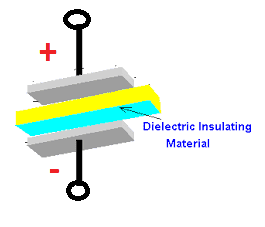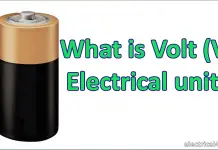Dielectric material:
A dielectric material is a medium or substance that opposes or blocks the flow of free electron (current) and works like insulator but it will allow the flow of electron through them when subjected to an external electric field as they can be polarized. It gives great support to the electrostatic fields. This word dielectric material is mainly used in capacitor designing. If the flow of current between opposite electric charge poles is kept to a minimum while the electrostatic lines of flux are not impeded or interrupted, an electrostatic field can store energy. This property is useful in capacitor s, especially at radio frequencies. Dielectric materials are also used in the construction of radio-frequency transmission lines.
[wp_ad_camp_1]
Example:
Solid dielectric material:
- Porcelain
- Mica
- Glass
- Oxides of Various material
- Plastics
- Laminated paper
Liquid dielectric material:
- Benzene
- Castor oil
- Liquid argon
- Liquid helium
- Liquid hydrogen
- Liquid nitrogen
- Liquid oxygen
- Mineral oil
- n-Heptane
- n-Hexane
- Polychlorinated biphenyls
- Purified water
- Silicone oil
Gas dielectric Material:
- Nitrogen
- SF6 gas
- Hydrogen
- Carbon dioxide
- Dry air
Others:
- Vacuum
Dry air and Vacuum both are very good dielectric material
Properties of dielectric material:
- Ability to support an electrostatic field
- Dissipating minimal energy in the form of heat
- It should have less the dielectric loss (the proportion of energy lost as heat),
- Lower dielectric constant the extent to which a substance concentrates the electrostatic lines of flux. Substances with a low dielectric constant include a perfect vacuum, dry air, and most pure, dry gases such as helium and nitrogen. Materials with moderate dielectric constants include ceramics, distilled water, paper, mica, polyethylene, and glass. Metal oxides, in general, have high dielectric constants.
Liquid dielectric Material Vs Solid dielectric material:
Dielectric liquids are used as electrical insulators in high voltage applications, e.g. transformers, capacitors, high voltage cables, and switchgear (namely high voltage switchgear). Its function is to provide electrical insulation, suppress corona and arcing, and to serve as a coolant.
Whenever breakdown or overvoltage (across the dielectric material, maximum due to lightning) occurs, if we use Liquid dielectric material’s components means it creates temporary conducting path between the two plates or we can say it as, it creates temporary short circuit path across the terminal, due to this the voltage across the terminal decrease, the system will be protected from some case. The dielectric material also comes to a Normal position. But in components containing solid dielectrics, dielectric breakdown usually results in permanent damage
The liquid dielectrics are used in the high voltage protection system.
Example: LAVT or LACPT panels
LAVT is the short form of lightning arrester voltage transformer
LACPT is Lightning arrester controlled potential transformer.
[wp_ad_camp_1]
Both the short terms word is doing the same function in overvoltage protection in the generation station. The output of the generation is directly given to LAVT or LACPT panels. The panel consists of 3 or more Potential transformers and three lightning arresters. Three lightning arrester consists of three liquid electrolytic capacitors. The capacitor is connected in between the phase terminal to earth point. During Normal condition, the capacitor will be in open condition. Whenever the voltage between terminal increases, then the capacitor creates short-circuit path and the high voltage will be suppressed. Once the voltage suppressed means, the capacitor comes to normal condition (open circuit)













![What is Arc Chute? Types, Working Principle [Video Included] arc chute working priciple](https://electrical4u.net/wp-content/uploads/2020/06/arc-chute-218x150.png)